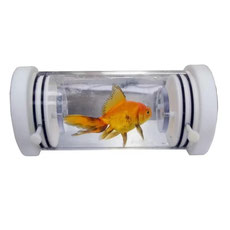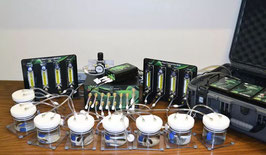Aquatic Animal Respirometry
We offer a wide range of measurement solutions for the monitoring of vertebrate and invertebrate respiration in marine (salt-water) and fresh-water aquatic environments:
- Q-Box AQUA Respirometry package, tailored for single or multichannel aquatic animal respiration monitoring, with a particular focus on dissolved oxygen (DO) depletion using an intermittent open flow system
- Q-AQUA-Mini Respirometry, for small aquatic organisms (larvae, etc.), using intermittent stop-flow measurements (DO),
- Q-OX1LP Dissolved Oxygen System, for the study of O2 exchange by "robust" fish eggs (cuvette is stirred!), microalgae and microorganisms,
- Rapid Response Dissolved CO2 System (Q-DCO2-RR), for measuring changes in dissolved CO2 at the ppm level, and
- Headspace Measurements of Aquatic Chambers, using the Q-RP1LP with aquatic chambers for gas-phase CO2 and O2 measurements.
Q-AQUA Aquatic Respirometry Package

Q-AQUA Aquatic Respirometry Package, designed to assess the metabolic rate (VO2) of aquatic animals by measuring the reduction of dissolved oxygen in a water-filled respirometry chamber. This comprehensive Q-AQUA system allows the study of both vertebrates and invertebrates (medium-sized, approx. >1 g) in water. Operating on the principle of intermittent flow respirometry, Q-AQUA allows the precise monitoring of up to four animals in aquatic chambers simultaneously during a single experiment, with the ability to incorporate additional components as required. It ensures uniform experimental conditions across all chambers, facilitating consistent and reliable data collection. For more details on the multi-channel Q-AQUA system Q-WSS, please contact us. Applications of the Q-AQUA include respirometry studies of aquatic vertebrates and invertebrates from a wide range of habitats.

Q-AQUA-Mini, extension of the Q-AQUA System to facilitate aquatic respirometry of small fish and insect larvae (weighing ~1 g). This modified version includes a 9 ml mini aquatic respirometer chamber and components designed for a reduced total system volume (incl. a smaller pump, PL100). The AQUA-Mini package contains also a 1.23 ml micro-chamber with a dissolved oxygen (DO; Q-S122) probe located at the top (see Fig.). This configuration allows the measurement of oxygen consumption rate (VO2) in exceptionally small specism such as larvae, juvenile fish, etc. (<0.5 g). The micro-chamber operates in intermittent stop-flow mode (closed chamber mode), increasing the sensitivity and resolution of the system for precise pO2 measurements.
Q-AQUA / Q-Aqua-Mini - features
- Optical Dissolved Oxygen Probe
- Small (140 ml) and large aquatic chamber (660 ml)
- Chambers can be flushed periodically with fresh water, avoiding hypoxia (intermittent flow mode)
- Water bath, temperature & salinity probe, pressure sensor included
- 6 channel data interface
- Data Acquisition and Control Software
Options:
- Q-AQUA-Mini extension, includes additional intermittent stop flow mode, a smaller pump and system volume, and two mini/micro chambers (9 ml / 1.23 ml) OR Q-AQUA-Mini modification, pump and chamber size replaced by versions for smaller organisms
- Custom aquatic chambers, user specified material and size (e.g. for larger organisms)
- Multi-channel Q-AQUA Q-WSS, up to 4 chambers
- Water control system
- Battery pack, for field work
| Components |
Q-AQUA Package, Q-AQUA-Mini Extension |
OPEN | ||||||||||||||||||||||||||||||||||||||||||||||||||||||||||||
|
|
||||||||||||||||||||||||||||||||||||||||||||||||||||||||||||||
| References | Q-AQUA Respirometry Package | OPEN |
|
||
Contact us to receive the manual of the Q-AQUA / Q-AQUA-Mini package, and details about the Q-WSS Multiplexer (4 Channels)
Operation of the Q-AQUA DO2 System
- All components of the Q-Box AQUA package are securely housed in a robust, weatherproof case for convenient transport and storage. After an easy experimental set-up of the components, the measurement process involves placing the aquatic animal (e.g. fish, Crustacea), in one of the included (or custom) respirometry chambers and quantifying the reduction in dissolved oxygen (DO2) due to the animal's uptake. Continue reading
-
The software displays dissolved O2 data, adjusted for salinity, temperature and pressure (all sensors included), and uses it to dynamically calculate values for oxygen consumption / respiration (VO2). Sequential measurements are taken without removing the aquatic animal from the chamber, ensuring continuous data collection. To prevent hypoxia, the chamber is periodically flushed with Oxygen-rich water between measurements - a notable advantage over continuous closed-circuit aquatic respirometry.
Throughout the experiment, water is circulated through the Q-AQUA animal chamber and flow-through vessel ("intermittent open flow" mode) by a liquid pump and an optical DO probe. The Digital Control Unit (DCU) and associated software controls a 3-way valve to determine whether the system is in recirculation or flush mode. In recirculation mode, respiration measurements are taken, whereas in flush mode, the animal chamber is flushed with oxygenated water from the water bath. This circulation-flushing cycle is repeated until the end of the experiment. Users can specify the duration of the flush and circulation phases via the software, providing flexibility and control in experimental design. In the Q-AQUA-Mini, the micro-chamber operates in intermittent stop-flow (closed chamber) mode, increasing the sensitivity and resolution of the system for precise pO2 measurements.
Headspace Measurement of Aquatic Animal Respiration

Headspace Aquatic Respirometry. As an alternative to the systems described above, single or multi-chamber (7 animals plus reference) measurements can be performed using an adapted setup for the Low Range Q-RP1LP Systems (used e.g. for Insect Respirometry) with 4- or 8-chamber Q-GSS Gas Switching Systems. The advantage of this "aquatic headspace"-setup is the flexible use of the gas phase CO2 and O2 analysers for both terrestrial and (occasionally) aquatic research needs - disadvantage the required "bubble stone". Please do not hesitate to contact us if this system is of interest to you.
For long-term monitoring and regulation of water temperature, pH, salinity and tubidity levels in experimental fish tanks etc., the Aquatic Control System Q-ACS is available to be customized.
Changes in dissolved O2 can be measured with the polarographic electrodes in the Q-OX1LP package under "no-flow" conditions- Attention: Clark-type electrode cuvettes are stirred!
To measure the CO2 and O2 exchange of terrestrial insects, consider the complete, ready-to-use Low Range Insect Respirometry Package.







